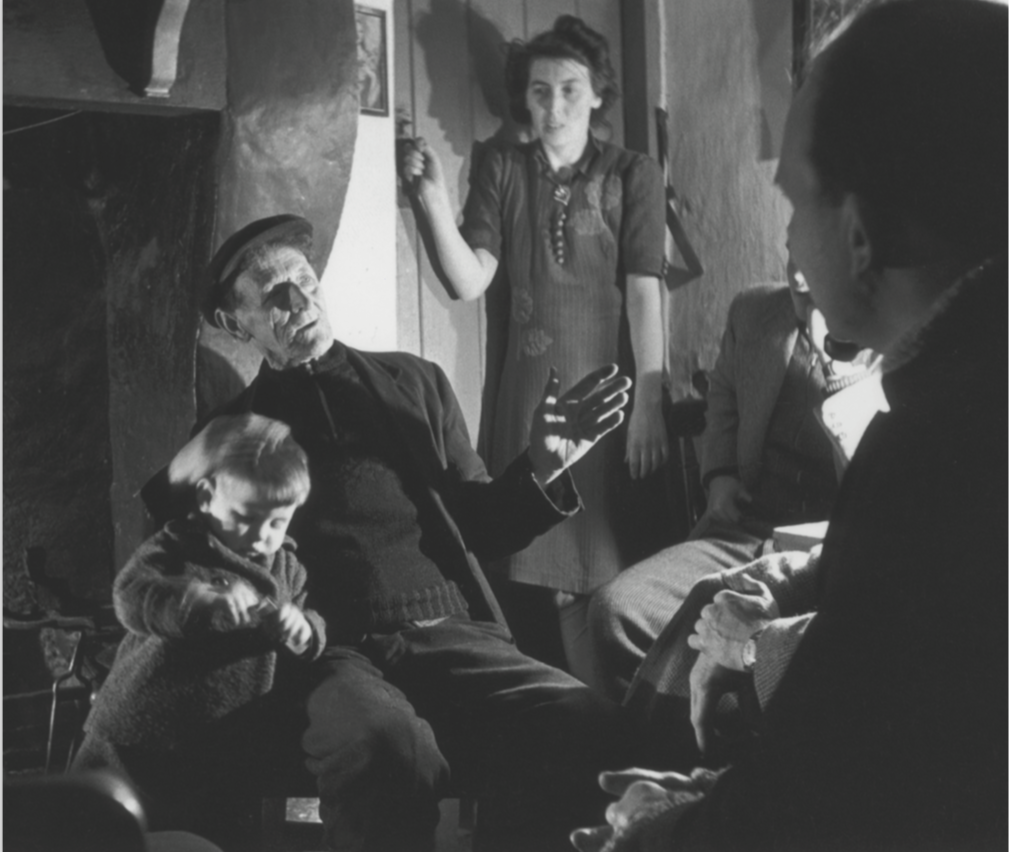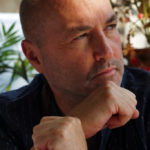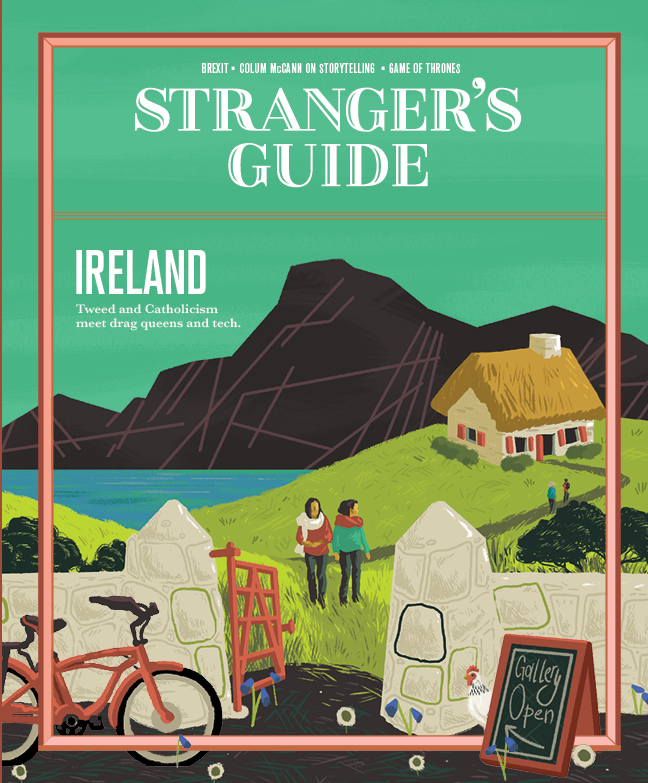
I have been out of Ireland for many years, but in fact, I have never left. She haunts me. Always has, always will. That’s what leaving will do to you: it forces you to remain.
The rippling waters of Lough Neagh. The trees in Powerscourt, bent by the rigors of weather. The swallows curving over the cliffs along the Giants Causeway, turning and returning, time and again.
When I come home—and I always call it “home” when I talk of Ireland—I want, immediately, to drive out toward Glendalough, where the light is, I think, more agile than anywhere else in the world. I want to head north to Coleraine, where a younger version of me—a child on holiday—inhabits my old, tired body. I want to swim in the frigid water at Sandycove, in what Joyce called the “scrotum-tightening sea.” I want to take a currach out and around the Aran Islands and call out to the ghost of J. M. Synge and all the other playboys of the western world. I want to wander the length of the Shankhill and the Falls Road, reading the graffiti on the Peace Walls. I want to watch a flock of long-billed snipe rise from the grass around Kiltimagh. I want to scuff up my liver in the Stag’s Head pub in Dublin.
There’s something fundamentally Irish about sitting down to tell a story.
But more than anything, when in Ireland, I want to spend time with the storytellers.
Stories are what we are, what we are made of. This is, of course, true around the world—we are all stitched together by narrative, whether we are in South Africa or Japan or Russia or Canada or Mexico—but I don’t know if there’s another place on this spinning rock where stories are so ambitiously told and received.
There’s something fundamentally Irish about sitting down to tell a story. Maybe it’s the rain that drives us indoors. Maybe it’s the booze. Maybe it’s the light that demands a sort of nuance. Maybe it’s the character that looks for an argument—we are famously wedded to our grudges. Maybe it’s the history of needing to stake a claim to a patch of land. Maybe it’s our religious heritage that has damned us with guilt. Maybe it’s because a story weaves the fabric of how we will be remembered, making us a part of forever.
But whatever it is, it hardly matters, because the stories are there, and we are legislated by them.
. . .
In September 2016, a global nonprofit agency—Narrative 4, built by authors and activists—opened up its doors in Limerick City Centre. The goal of Narrative 4 (of which I am a co-founder, along with Lisa Consiglio and several other artists, including Ishmael Beah and Terry Tempest Williams) was to spread the idea that storytelling can expand the lungs of the world.
Limerick was for many years on the periphery of the Irish respiratory system. The city was always seen as a rough place, the poor cousin, the delinquent upstart. It had the dubious distinction of being called “Stab City” by other parts of the country. O’Connell Street, where Narrative 4 is located, was once the beating heart of the city, but until the 2010s, it had taken a downturn. The windows in the old Georgian houses were broken. The steps were cracked. The gardens were overgrown. The flats were abandoned. But what was still apparent on the streets was the powerful pulse of the people.
Ireland haunts me. Always has, always will. That’s what leaving will do to you: it forces you to remain.
There was always something in Limerick that aligned itself with stories and storytellers. There was Kate O’Brien, one of Ireland’s leading novelists—some of her books, indeed, have been censored. There was Frank McCourt, tilting against the rain and the small-minded ones, fumbling in the till and adding the halfpence to the pence. There were the late Michael Hartnett and Eithne Strong. There are, nowadays, Marian Keyes and Donal Ryan and Kevin Barry and, of course, Michael D. Higgins, the current President of Ireland and a renowned poet.
Limerick is a city that seems to want a story: it desires it, it has a taste like salt in its mouth. The city is different from others in that respect. Dublin and Cork and Belfast and even Galway want to be talked about, but Limerick is the sort of place that wants to be listened to.
So Limerick seemed like a natural place in which to set up a storytelling center where young people from across the city, and indeed the globe, could come together to step into one another’s shoes. That is the fundamental tenet of Narrative 4: “You tell my story, I will tell yours.” This act of radical empathy is designed so that the true function of stories—to connect us and bring us alive in bodies not our own—can not only live on, but flourish. This flourishing happens most spectacularly when we are listening to the stories of others. If we listen to others, we can have as many lives as we want. What is the world except the story of everyone else?
And so it was that Narrative 4—with the help of the Limerick City and County Councils—renovated a dilapidated Georgian townhouse that once served as a public library, and designed a state-of-the-art creative facility that is now called home. Students came to the old Georgian house to connect.
Schools were linked together all over the world. Readings developed into lively discussions. Young people began to develop empathy into action programs. A small room became the world.
The challenge was to see whether stories could really bind a community together.
There are a substantial number of refugees living in Ireland nowadays—from Syria, Somalia, Kenya and elsewhere. The Eastern European population has mushroomed. The big debate during the 2018 World Cup—given that Ireland had not qualified either north or south—was whether to support Croatia or Poland.
And so the challenge was to see whether stories could really bind a community together, if the notion of becoming other actually allows us to become ourselves. And maybe in the process, we can even expand the idea of Irishness: something that might belong to you and me and that other distant person whom we have not yet met.
. . .
After we have satisfied the fundamental needs for water, food, shelter and companionship, storytelling is the thing that we go to most for encouragement in how to live. We discover a way to make sense of the world in all its beauty and its ruin. Stories are the most common—and, therefore, potentially the most democratic—things we have in the world. And yet we tell them precisely because our experience has been so uncommon. No two stories are ever the same. There is no Olympics in storytelling. There is no gold medal, but nor is there a wooden spoon.
The Narrative 4 center in Limerick gave people—locals and refugees, northerners and southerners, rural and urban—a chance to understand one another by becoming one an other. The primary focus was on young people, mostly ages 16 through 18. Guided by teachers, they took the challenge. Whole schools came together. Community activists revolutionized ideas of belonging. Intergenerational story exchanges took place. Visitors came from schools in South Africa, Mexico, the United States, Rwanda, Colombia and elsewhere.
Several programs were started, amongst them a pioneering project that brought young Irish and English teenagers together. In November 2017, 15 students from the Gaelcholaiste Luimnigh, a school in Limerick that teaches all subjects through the Irish language, were paired with 15 students from three schools in Birmingham. The weekend was coordinated by the Irish novelist Ruth Gilligan and the British author David Savill. The 30 young people met in person to discuss the theme of identity. They talked of bullying, self-harm, sexual violence, eating disorders, the prospect of Brexit. They stepped into one another’s shoes. Their stories were far-ranging and provocative. The weekend left its mark. Each of the young people felt dynamically changed. Friendships were forged. New understanding emerged. No sign of any of the ancient enmities between Ireland and England were on display. Theirs was a new world, painted by stories and storytelling.
. . .
One of the beauties of storytelling, and of stories themselves, is that they can capture—and hold—contradiction. It is our ability to tell stories that is fundamental to how we celebrate and examine our lives. Historically speaking, we Irish have always preferred the question to the answer in our struggle for definition. When left with the answer alone, our strategy is simple: change the question.
One of the beauties of storytelling, and of stories themselves, is that they can capture—and hold—contradiction.
Let’s face it: we can be torturously poetic, unbearably self-conscious, awkwardly comic and willfully ambiguous, but so what? Nuance is where the truth lies, and nuance comes through the art of relating what has happened to us. Instead of dictating to the world who we are, we like to allow the world to discover what we are through our stories. After all, facts are mercenary bastards. You can pack them up wherever you want them to go. But a story—be it imagined or real—gets in under the skin.
Our penchant for storytelling, and indeed for poetry, speaks to our desire to be everywhere. We’re a promiscuous race, the Irish, at least in terms of our desire for experience to get out and about in the world. No matter what small corner you are in, you will always find an Irish person there; and in telling their stories, they display the classic desire of the emigrant: the need to go home.
“I have been so long out of Ireland that I can all at once hear her voice in everything,” said James Joyce.
A country is composed of its people far more than its landscape. And a people is composed of how it talks not only about itself, but how it talks about others. It is the eternal dream to keep on becoming something new. What emerges from the art of storytelling is the realization that we are so much more than one thing. Labels like Irish or English, or Christian or Muslim, or straight or gay, are no more than starting points. When followed into actual experience, the labels are left behind. Our identities become infinitely more complex. Survival is about connection. We learn to think contrapuntally and beyond our traditional borders. When we tell the story of someone else, we learn to resist hierarchies. There are other echoes in our heads. It is both difficult and rewarding to listen to these echoes. By asserting the ancient art of storytelling we, in the end, become ourselves. At the same time, we do, in fact, expand the lungs of the world.
And that’s another reason to keep coming home.




